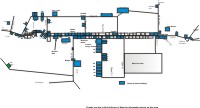The History of Wem
Wem is a typical example of what an English market town used to be like. In the Middle Ages, there was a market town every 10 miles or so in each direction, so that villagers
could venture forth and do their weekly shop, or could catch a stage-coach further afield. From Wem, there is Ellesmere, Whitchurch, Newport, Market Drayton and Shrewsbury all
within the 10 miles radius.
In the Civil War, it was fortified by the Parlimentarians who held it against considerable Royalist force.
The High Street is probably famous for having witnessed the Town Hall being being burned down- twice! Having lost the initial hall in 1677, it was rebuilt in 1848 and again in
1905. It then burned down again in 1995 and was rebuilt with lottery money. Rumour suggested that the 2nd fire was started by the ghost of Jane Churn, who was accused of accidently
starting the previous fire. North Shropshire District Council then tried to ensure that this would not happen again by closing it down. This situation existed until the early 21st
century when, in conjunction with Thomas Adams Secondary School, it was re-opened as a learning, arts, community and enterprise centre, equipped with both a cafe and a market hall.
It has proved to be very popular.
The 18th Century town had a full range of shops, all run by local traders. Today, Wem may lack a certain range (shoes and clothing particularly) but it is still possible to buy most
everyday goods. In 2012, the Co-op and Rowlands the Chemists were the only 'national' stores in the town.
One resident remembers the scene:
Between the wars, walking from the now Wem Book Shop, along the High Street to the Maypole Corner you could have browsed in over thirty shop premises and buy all your clothes and
household needs. Shops I.m sure you'll remember were, Ridgeways, bakers; Miss Hopes, Haberdashers; Miss Burrows, china; Tudors, bakers; Kynastons, hardwar.
Across the street,
Rutters bakers, further down Rutters butchers. Moss's cycles, Hiltons, shoes; Dawes and Heath, pork butchers; Butlers, mens outfitters; Bowens, ladies fashion; and much more!
Jones, fruit and veg. Lees, High class grocers. Griffiths, drapers. Mrs Rowlands, sweets. Sands, grocers. Johnsons butchers. Morgans chemist,
Ikins milliners and corsets; Eatons, outfitters; Obertelli, fish and chips, plus ice cream! Morris, drapers; Hidens, paper shop. Many other small shops were just off the High Street.
You could mend your clocks,your shoes and tinware. Farm supplies, animal feeds, and parts for vehicles. The markets were for cheese, and local fresh produce.
The Smithfield sold your cattle, or your Christmas geese. The Brewery and wood yards along with maltsters were industries in the centre of the town.
 |
Today, the same largely Timber framed and Georgian frontages survive unvandalised with almost 90 GRADE II listings, mostly in the town centre and side streets. Astley House,in front of the old brewery, is a particularly good example of the former while 69, the High Street has a very fine Georgian frontage. Click on the map to see these illustrated, or go to www.britishlistedbuildings.co.uk/england/shropshire/wem+urban to see the details. |
|

